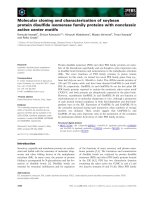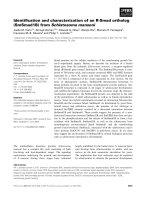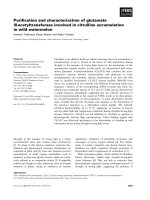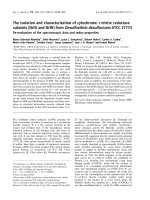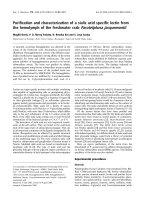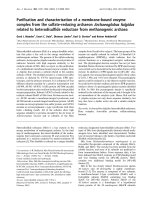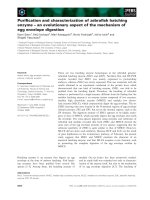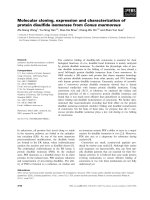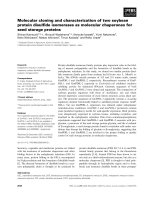Báo cáo khoa học: Molecular cloning and characterization of methylenedioxy bridge-forming enzymes involved in stylopine biosynthesis in Eschscholzia californica doc
Bạn đang xem bản rút gọn của tài liệu. Xem và tải ngay bản đầy đủ của tài liệu tại đây (1.36 MB, 17 trang )
Molecular cloning and characterization of methylenedioxy
bridge-forming enzymes involved in stylopine biosynthesis
in Eschscholzia californica
Nobuhiro Ikezawa
1
, Kinuko Iwasa
2
and Fumihiko Sato
1
1 Division of Integrated Life Science, Graduate School of Biostudies, Kyoto University, Japan
2 Kobe Pharmaceutical University, Japan
Higher plants produce structurally divergent chemi-
cals, such as terpenoids, phenylpropanoids, and alka-
loids [1]. Throughout human history, several plant
materials have been used in natural medicines
because of the pharmacological activities of these
chemicals.
Isoquinoline alkaloids are a large group of alkaloids,
and include many pharmacologically useful compounds,
Keywords
alkaloid biosynthesis; cytochrome P450;
Eschscholzia californica; methylenedioxy
bridge-forming enzyme; stylopine synthase
Correspondence
F. Sato, Division of Integrated Life Science,
Graduate School of Biostudies, Kyoto
University, Kyoto 606-8502, Japan
Fax: +81 75 753 6398
Tel. +81 75 753 6381
E-mail:
Note
The nucleotide sequences reported in this
paper have been submitted to the
DDBJ ⁄ GenBank ⁄ EMBL Data Bank under
the accession numbers AB126257
(CYP719A2) and AB126256 (CYP719A3)
(Received 6 September 2006, revised 23
November 2006, accepted 15 December
2006)
doi:10.1111/j.1742-4658.2007.05652.x
(S)-Stylopine is an important intermediate in the biosynthesis of benzophe-
nanthridine alkaloids, such as sanguinarine. Stylopine biosynthesis involves
the sequential formation of two methylenedioxy bridges. Although the
methylenedioxy bridge-forming P450 (CYP719) involved in berberine bio-
synthesis has been cloned from Coptis japonica [Ikezawa N, Tanaka M,
Nagayoshi M, Shinkyo R, Sakaki T, Inouye K & Sato F (2003) J Biol Chem
278, 38557–38565], no information is available regarding the genes for
methylenedioxy bridge-forming enzymes in stylopine biosynthesis. Two cyto-
chrome P450 cDNAs involved in stylopine biosynthesis were isolated using
degenerate primers designed for C. japonica CYP719 from cultured Esch-
scholzia californica cells. Heterologous expression in Saccharomyces cerevisi-
ae showed that both CYP719A2 and CYP719A3 had stylopine synthase
activity to catalyze methylenedioxy bridge-formation from cheilanthifoline
to stylopine, but not cheilanthifoline synthase activity to convert scoulerine
to cheilanthifoline. Functional differences and expression patterns of
CYP719A2 and CYP719A3 were examined to investigate their physiological
roles in stylopine biosynthesis. Enzymatic analysis showed that CYP719A2
had high substrate affinity only toward (R,S)-cheilanthifoline, whereas
CYP719A3 had high affinity toward three similar substrates (R,S)-cheilan-
thifoline, (S)-scoulerine, and (S)-tetrahydrocolumbamine. An expression
analysis in E. californica plant tissues showed that CYP719A2 and
CYP719A3 exhibited expression patterns similar to those of three stylopine
biosynthetic genes (CYP80B1, berberine bridge enzyme, and S-adenosyl-
l-methionine : 3¢-hydroxy-N-methylcoclaurine 4¢-O-methyltransferase),
whereas the specific expression of CYP719A3 in root was notable. Treatment
of E. californica seedlings with methyl jasmonate resulted in the coordinated
induction of CYP719A2 and CYP719A3 genes. The physiological roles of
CYP719A2 and CYP719A3 in stylopine biosynthesis are discussed.
Abbreviations
BBE, berberine bridge enzyme; CHS, (S)-cheilanthifoline synthase; MeJA, methyl jasmonate; 4¢-OMT, S-adenosyl-
L-methionine : 3¢-hydroxy-
N-methylcoclaurine 4¢-O-methyltransferase; P450, cytochrome P450; RNAi, RNA interference; (S)-THB, (S)-tetrahydroberberine; (S)-THC,
(S)-tetrahydrocolumbamine; STS, (S)-stylopine synthase.
FEBS Journal 274 (2007) 1019–1035 ª 2007 The Authors Journal compilation ª 2007 FEBS 1019
such as morphine. Despite their structural diversity,
most isoquinoline alkaloids are found in limited and
evolutionarily old taxonomic groups within the plant
kingdom, i.e. Papaveraceae, Ranunculaceae, Berberida-
ceae, Menispermaceae, and a few other families. Among
the wide array of chemicals produced in these plant
families, some are known to share, at least in part,
common biosynthetic pathways, e.g. a key intermediate
(S)-reticuline [1].
The Papaveraceae plant California poppy, Esch-
scholzia californica, is a traditional medicinal plant of
Native Americans, and has been well investigated
because of the variety and pharmacological effects of
its alkaloids. One of the alkaloids produced by this
plant is the antimicrobial sanguinarine, which had
been used as the component of toothpastes and
mouthwashes. The biosynthetic pathways of sanguina-
rine, as well as other benzophenanthridine-type alka-
loids chelirubine and macarpine, have been completely
elucidated at the enzyme level [2,3]. These highly oxid-
ized chemicals are biosynthesized from two molecules
of l -tyrosine via the central intermediate (S )-stylopine.
(S)-Stylopine, which has two methylenedioxy groups in
rings A and D of its protoberberine skeleton, is pro-
duced by a three-step conversion from the key interme-
diate (S)-reticuline; berberine bridge enzyme (BBE)
catalyzes oxidative cyclization of the N-methyl moiety
of (S)-reticuline to produce (S)-scoulerine [4,5], and
two cytochrome P450s (S)-cheilanthifoline synthase
(CHS; EC 1.14.21.2) and ( S )-stylopine synthase (STS;
EC 1.14.21.1), sequentially form two methylenedioxy
bridges from (S )-scoulerine via (S)-cheilanthifoline to
(S)-stylopine [6,7] (Fig. 1). These two P450s (CHS and
STS) have been studied in part by using microsomal
fractions of cultured E. californica cells [7]. In that
report, CHS and STS were found to be two independ-
ent P450s, although they both catalyze methylenedioxy
bridge-forming reactions using similar substrates
[(S)-scoulerine and (S)-cheilanthifoline]. Because many
P450s, especially those involved in the detoxification of
xenobiotics, are known to have relatively broad sub-
strate specificity [8], CHS and STS reactions might be
catalyzed by a single P450 in different ways, or CHS
and STS may be two homologous P450s. To clarify
this point, we tried to isolate methylenedioxy bridge-
forming P450 cDNA(s) from E. californica.
Previously, we isolated the first methylenedioxy
bridge-forming P450 (CYP719) cDNA, the protein of
which catalyzed the conversion of (S)-tetrahydroco-
lumbamine to (S)-tetrahydroberberine [(S)-canadine] in
berberine biosynthesis, from cultured cells of Japanese
goldthread Coptis japonica (Ranunculaceae) (Fig. 1)
[9]. C. japonica produces a large amount of berberine,
which has been used as a medicine, for example as a
stomach tonic, and the biosynthesis of berberine has
been intensively studied [10,11]. Because C. japonica
cells also produce coptisine [12], oxidized stylopine, it
has been proposed that stylopine is biosynthesized in
C. japonica. However, C. japonica CYP719 did not
show CHS activity, although it is possible that it had
STS activity, which we were not able to check because
of a lack of the substrate cheilanthifoline. Because no
previous report has described stylopine biosynthesis in
C. japonica, it is possible that a coptisine biosynthetic
pathway in C. japonica may not be similar to the
known stylopine biosynthetic pathway in E. californica.
Because both CHS and STS catalyze methylenedioxy
bridge-forming reactions using substrates quite similar
to that of C. japonica CYP719 (Fig. 1), we speculated
that the primary structures of CHS and STS in E. cali-
fornica may be homologous to that of C. japonica
CYP719. Based on this idea, we amplified cDNA frag-
ments that were homologous to C. japonica CYP719
from single-stranded cDNAs prepared from cultured
E. californica cells. Next, we isolated two full-length
cDNAs and characterized the enzymological activity of
their recombinant proteins produced in a S. cerevisiae
expression system. Both of these CYP719 homologs
(CYP719A2 and CYP719A3) showed methylenedioxy
bridge-forming activity to convert cheilanthifoline to
stylopine (STS activity), but no activity to convert
scoulerine to cheilanthifoline (CHS activity). In addi-
tion, they used scoulerine as the substrate to produce
nandinine, which has a methylenedioxy bridge in
ring A (2,3-position) of scoulerine. Based on their
enzymological properties (substrate specificity and kin-
etic parameters) and expression profiles, we discuss the
physiological roles of CYP719A2 and CYP719A3 in
stylopine biosynthesis in E. californica.
Results
Isolation of cytochrome P450 cDNAs
To examine the presence of C. japonica CYP719
homologs and their functions in stylopine biosynthesis
in E. californica, cytochrome P450 (P450) cDNA frag-
ments were amplified from single-stranded cDNAs,
prepared from cultured E. californica cells, using the
degenerate primers designed for the P450-conserved
regions specific to C. japonica CYP719 [9]. After nested
PCR, clear PCR products at 280 bp were obtained
and subcloned into pT7Blue T-vector. Sequence analy-
sis of two clones indicated that amplified cDNA frag-
ments had an identical sequence that was highly
homologous (73.2% identity for 280 bp PCR product)
Stylopine synthase from Eschscholzia californica N. Ikezawa et al.
1020 FEBS Journal 274 (2007) 1019–1035 ª 2007 The Authors Journal compilation ª 2007 FEBS
Fig. 1. Biosynthetic pathway for a variety of isoquinoline alkaloids. (S)-Scoulerine is an intermediate at the branch point leading to benzophe-
nanthridine alkaloids in E. californica or berberine in C. japonica. The pathway from (S)-scoulerine to berberine is thought not to exist in
E. californica, but is the main pathway in C. japonica (surrounded by dotted line). CYP80B1, (S)-N-methylcoclaurine 3¢-hydroxylase; 4¢-OMT,
S-adenosyl-
L-methionine:3¢-hydroxy-N-methylcoclaurine 4¢-O-methyltransferase; BBE, berberine bridge enzyme.
N. Ikezawa et al. Stylopine synthase from Eschscholzia californica
FEBS Journal 274 (2007) 1019–1035 ª 2007 The Authors Journal compilation ª 2007 FEBS 1021
to the corresponding region of C. japonica CYP719
cDNA (designated EcCYPA). To isolate a full-length
clone of EcCYPA, 5¢- and 3¢-RACE were conducted.
Although a full-length sequence of EcCYPA was
obtained, another sequence obtained with 5¢-RACE
showed a minor but distinct change from EcCYPA
(named EcCYPB). A full-length clone of EcCYPB was
also isolated with 5¢- and 3¢-RACE.
Nucleotide sequences and predicted amino acid
sequences
Sequence analysis confirmed that the longest full-
length EcCYPA carried 1916 nucleotides, with an
ORF that encoded 495 amino acids (accession number
AB126256), and full-length EcCYPB contained 1718
nucleotides, with an ORF that encoded 495 amino
acids (accession number AB126257). EcCYPA and
EcCYPB were also highly homologous to C. japonica
CYP719 at the amino acid level (64.8 and 65.1% iden-
tity, respectively), and the identity between EcCYPA
and EcCYPB was 84.6%. These predicted amino acid
sequences were classified into the same family as
C. japonica CYP719 by the P450 nomenclature com-
mittee (D.R. Nelson, University of Tennessee, Mem-
phis, TN). According to the suggestion of the
nomenclature committee, C. japonica CYP719 was
renamed CYP719A1, and EcCYPA and EcCYPB were
designated CYP719A3 and CYP719A2, respectively.
Sequence analysis also showed that CYP719A2 and
CYP719A3 had conserved eukaryotic P450 regions: a
helix K region, an aromatic region, and a heme-bind-
ing region at the C-terminal end (Fig. 2). In addition,
their N-terminal regions contained hydrophobic
domains that corresponded to the membrane anchor
sequences of microsomal P450 species, which suggested
that CYP719A2 and CYP719A3 were located in the
endoplasmic reticulum. Notably, a conserved threonine
(corresponding to Thr252 of P450cam), which plays a
significant role in oxygen activation [13], has been
replaced by serine in both CYP719A2 and CYP719A3
as in C. japonica CYP719A1 (Ser299 of both
Fig. 2. Amino acid sequence alignment of the CYP719 family. Boxes indicate conserved regions of eukaryotic P450, which are the helix K
region, aromatic region, and heme-binding region. The box with dotted line in the helix-K region indicates the conserved EXXR motif, which
is canonical to all P450s. The arrows below the sequences indicate degenerate primers (Fw1, Fw2, and Rv1) used for the amplification of
CYP719 homologous cDNA fragments from E. californica. The asterisk indicates the position of Ser299 of CYP719A2 and CYP719A3, which
replaces the conserved threonine. CYP719A1, methylenedioxy bridge-forming enzyme from C. japonica (accession number AB026122).
Stylopine synthase from Eschscholzia californica N. Ikezawa et al.
1022 FEBS Journal 274 (2007) 1019–1035 ª 2007 The Authors Journal compilation ª 2007 FEBS
CYP719A2 and CYP719A3). This substitution is only
found in a few species, such as Zea mays CYP88A1
(accession number U32579) and Nicotiana tabacum
CYP92A2 (accession number X95342).
Because the primary structures of CYP719A2 and
CYP719A3 were so similar to that of C. japonica
CYP719A1, these P450s were speculated to catalyze
methylenedioxy bridge-forming reactions similar
to C. japonica CYP719A1. Although C. japonica
CYP719A1 is involved in berberine biosynthesis, it has
been reported that E. californica does not produce a
detectable level of berberine [14–17]. Thus, CYP719A2
and CYP719A3 appear to be involved in a biosynthetic
pathway other than berberine biosynthesis. In contrast to
C. japonica, E. californica produces a large amount of the
benzophenanthridine alkaloid sanguinarine [14,15,18],
the biosynthesis of which requires two consecutive methy-
lenedioxy bridge-forming reactions from (S)-scoulerine
via (S)-cheilanthifoline to (S)-stylopine, i.e. CHS and
STS reactions. Because (S)-scoulerine and (S)-cheilanthi-
foline are structurally similar to (S)-tetrahydrocolumb-
amine [(S)-THC], the substrate of C. japonica CYP719A1
[9], we examined whether CYP719A2 and CYP719A3
could function as CHS or STS.
Heterologous expression of CYP719A2 and
CYP719A3 in S. cerevisiae and their
enzymological activities
CYP719A2 and CYP719A3 were heterologously
expressed in S. cerevisiae to characterize their enzymo-
logical activities. S. cerevisiae expression plasmids for
CYP719A2 and CYP719A3 were constructed and
introduced into the S. cerevisiae strain AH22. Because
both CYP719A2 and CYP719A3 had putative endo-
plasmic reticulum-localizing signals, microsomal frac-
tions were prepared from recombinant S. cerevisiae
cells, and their enzymatic activities were determined
using LC-MS.
Microsomal fractions prepared from transgenic
S. cerevisiae cells of both CYP719A2 and CYP719A3
showed STS activity, i.e. they catalyzed methylenedi-
oxy bridge-formation from (R,S)-cheilanthifoline to
stylopine (Fig. 3). The formation of stylopine from
cheilanthifoline was confirmed by direct comparison of
the reaction product with standard stylopine. Although
the concentration of ( R ,S )-cheilanthifoline used for
enzyme assays was low (0.4 lm) due to its low availab-
ility, recombinant CYP719A2 and CYP719A3 were
able to convert it to stylopine, suggesting that both
CYP719A2 and CYP719A3 function as STS.
However, when (S)-scoulerine was used as the sub-
strate, neither CYP719A2 nor CYP719A3 produced
cheilanthifoline, but rather produced another product
(see below). By contrast, C. japonica CYP719A1 does
not utilize (S)-scoulerine [9], and did not utilize (R,S)-
cheilanthifoline at a concentration of 0.4 l
m (data not
shown), despite its K
m
value of 0.27 lm toward (S)-
THC [9]. These results suggested that members of the
CYP719 family (CYP719A1–A3) have different sub-
strate specificities and ⁄ or reaction activities.
P450 natures of CYP719A2 and CYP719A3
The P450 natures of CYP719A2 and CYP719A3 were
examined using reduced CO-difference spectra (Fig. 4).
Whereas CYP719A2 expressed in S. cerevisiae cells
showed a characteristic peak at 450 nm with a content
of 30 pmol P450 per mg microsomal protein, the micro-
somal fraction of CYP719A3 expressed in S. cerevisiae
cells showed indistinguishable spectral pattern from
that of control S. cerevisiae cells harboring empty
plasmid. Because the expression level of CYP719A3 in
S. cerevisiae cells was low, we characterized their P450
natures, particularly that of CYP719A3, based on their
reaction dependencies on NADPH and oxygen using
(S)-scoulerine as the substrate (Table 1). The absence of
NADPH or removal of O
2
by the glucose ⁄ glucose
oxidase ⁄ catalase system [7] clearly inhibited the
CYP719A2 and CYP719A3 activities.
Substrate specificity and affinity of CYP719A2
and CYP719A3
To investigate which of these P450s, CYP719A2 or
CYP719A3, functions mainly as STS, their detailed
substrate specificity was examined using several types
of alkaloids harboring an ortho-methoxyphenol moiety
at 10 lm (Fig. 5). LC-MS analysis showed that
CYP719A2 and CYP719A3 could convert (S)-scouler-
ine to a new product with a reduction of 2 m ⁄ z. This
new product was suggested to be nandinine based
on its total m ⁄ z and fragment ion patterns (data
not shown). Nandinine is a scoulerine derivative with
the methylenedioxy bridge in ring A (2,3-position),
whereas cheilanthifoline is a derivative with the
methylenedioxy bridge in ring D (9,10-position).
Because neither CYP719A2 nor CYP719A3 catalyzed
the methylenedioxy bridge-formation in ring D of
scoulerine, they should strictly recognize ring A of
the substrate. Whereas CYP719A3 also converted
(S)-THC to (S)-tetrahydroberberine [(S)-THB],
CYP719A2 did not (data not shown). Neither
CYP719A2 nor CYP719A3 reacted with any of seven
other compounds [columbamine, (R,S)-reticuline, (R,S)-
norreticuline, (S)-N-methylcoclaurine, (S)-coclaurine
N. Ikezawa et al. Stylopine synthase from Eschscholzia californica
FEBS Journal 274 (2007) 1019–1035 ª 2007 The Authors Journal compilation ª 2007 FEBS 1023
(R,S)-6-O-methylnorlaudanosoline, and magnoflorine]
to make their corresponding products with a methylen-
edioxy bridge. Also, neither CYP719A2 nor CYP719A3
catalyzed methylenedioxy bridge-formation with a
(S)-scoulerine derivative, which was produced from
(S)-scoulerine by S-adenosyl-l-methionine : coclaurine
TIC
m/z=326
m/z=324
min
10 20 30
(R,S)-cheilanthifoline;
m/z=326
H
3
CO
CO
HO
HO
N
O
O
0
10
8
6
4
2
0
height
( 10
6
)
A
TIC
m/z=326
m/z=324
min
10 20 30
reaction product
0
10
8
6
4
2
0
height
( 10
6
)
B
TIC
m/z=326
m/z=324
min
reaction product
10 20 30
0
10
8
6
4
2
0
height
( 10
6
)
C
TIC
m/z=326
m/z=324
min
10 20 30
(R,S)-stylopine; m/z=324
O
O
N
O
O
0
10
8
6
4
2
0
height
( 10
5
)
D
Fig. 3. LC-MS analysis of reaction products
of CYP719A2 and CYP719A3 using (R,S)-ch-
eilanthifoline as the substrate. Vector control
reaction (A), CYP719A2 reaction (B),
CYP719A3 reaction (C), and authentic
(R,S)-stylopine (D) are shown. TIC, total ion
chromatogram.
Stylopine synthase from Eschscholzia californica N. Ikezawa et al.
1024 FEBS Journal 274 (2007) 1019–1035 ª 2007 The Authors Journal compilation ª 2007 FEBS
N-methyltransferase [19] and was predicted to be
N-methylated (S)-scoulerine.
Because the above results suggested that (R,S)-chei-
lanthifoline and (S)-scoulerine would be competitive
substrates for CYP719A2 and CYP719A3, we exam-
ined the reaction specificity using a mixture of these
compounds at 0.4 lm each. As shown in Fig. 6,
CYP719A2 exclusively used (R,S)-cheilanthifoline as
a substrate to produce stylopine. By contrast,
CYP719A3 converted (R,S)-cheilanthifoline and
(S)-scoulerine to stylopine and nandinine at a compar-
able level (Fig. 6). Furthermore, when (R,S)-cheilan-
thifoline and (S)-THC were used as mixed substrates
at 0.4 lm each, CYP719A3 showed comparable methy-
lenedioxy bridge-forming activities with both substrates
(Fig. 6). These results indicated that CYP719A3 had
broader substrate specificity than CYP719A2, although
only the ring A (2,3-position) of the substrates was
converted.
Next, the substrate affinities of CYP719A2 and
CYP719A3 were determined to examine their functions
in greater detail. Enzyme activity was quantified by
HPLC using (R,S)-scoulerine (for CYP719A2) or
(S)-scoulerine (for CYP719A3) as the substrates, due
to the low availability of (R,S)-cheilanthifoline. Both
P450s showed Michaelis–Menten-type reaction kinetics
when the substrate concentration was varied. The kin-
etic parameters, K
m
and V
max
, of CYP719A2 were esti-
mated to be 32 ± 7.1 lm and 0.43 ± 0.04 pmol
productÆmin
)1
Æpmol
)1
P450, respectively, whereas those
of CYP719A3 were estimated to be 0.54 ± 0.03 lm
and 4.5 ± 0.03 pmol productÆmin
)1
Æmg
)1
microsomal
protein. These differences in the K
m
values for scouler-
ine explain the different reactivities of CYP719A2
and CYP719A3 for the mixture of cheilanthifoline and
scoulerine (Fig. 6), because both CYP719A2 and
CYP719A3 catalyzed (R,S)-cheilanthifoline compar-
ably at a substrate concentration of 0.4 lm (Fig. 3).
Expression of CYP719A2 and CYP719A3 genes in
E. californica plants: tissue specificity and their
response to methyl jasmonate (MeJA)
We examined the accumulation of mRNA of CYP719A2
and CYP719A3 in E. cali fornica plant tissues (leaf, stem,
and root) in comparison with three stylopine biosynthetic
genes, CYP80B1 [(S)-N-methylcoclaurine 3¢-hydroxylase]
[20], BBE [4,5], and S-adenosyl-l-methionine : 3¢-hydroxy-
N-meth ylcoclaurine 4¢-O-methyltransferase (4¢-OMT) [21,
21a] (Fig. 7). As a r esult, all of the genes e xamined showed
similar expression patterns; the expression in root was
greater than that in the leaf and stem, which suggests that
both CYP719A2 and CYP719A3 are involved in alkaloid
Absorbance (10
-3
)
4
-4
0
400 500450
Wavelen
g
th (nm)
Absorbance (10
-3
)
4
-4
0
400 500450
Wavelen
g
th (nm)
AB
Fig. 4. Reduced CO-difference spectra of
CYP719A2 and CYP719A3 heterologously
expressed in S. cerevisiae. Reduced
CO-difference spectra were recorded using
microsomal fractions of recombinant
S. cerevisiae (1 mg proteinÆmL
)1
). Solid line
is the spectrum of the microsomal fraction
from CYP719A2-expressing S. cerevisiae (A)
or CYP719A3-expressing S. cerevisiae (B).
Dotted line is the spectrum of the micro-
somal fraction from control S. cerevisiae
transformed with empty plasmid.
Table 1. Methylenedioxy bridge-forming activity of CYP719A2 and
CYP719A3 toward (S)-scoulerine without NADPH or oxygen. The
reaction was carried out under standard assay conditions except
for the amounts of enzyme preparations (200 n
M P450 for
CYP719A2 or 1.1 lgÆlL
)1
of microsomal protein for CYP719A3)
after removal of NADPH or oxygen with glucose ⁄ glucose oxidase.
U, units.
Addition
Relative activity
CYP719A2
%
CYP719A3
%
None 100 100
– NADPH 0 0
40 m
M glucose
+5 U glucose oxidase
+10 U catalase
04
40 m
M glucose
+ boiled glucose oxidase
+10 U catalase
100 105
N. Ikezawa et al. Stylopine synthase from Eschscholzia californica
FEBS Journal 274 (2007) 1019–1035 ª 2007 The Authors Journal compilation ª 2007 FEBS 1025
biosynthesis (Fig. 7). Notably, CYP719A3 showed extre-
mely high expression in root compared with the other tis-
sues ( 30 times h igher than in leaf), whereas other genes
only showed a moderate increase in expression in root
( 3–6 times higher t han i n l eaf). W hen t he probable relat-
ive expression levels of CYP719A2 and CYP719A3 were
Fig. 5. Chemical structures of compounds
tested as potential substrates for CYP719A2
and CYP719A3. The apparent natural sub-
strate (R,S)-cheilanthifoline is boxed. Iso-
quinoline alkaloids with an ortho-
methoxyphenol moiety were tested as
potential substrates. The structure of
‘N-methylated (S)-scoulerine’ is speculated
based on the reaction mechanism of
S-adenosyl-
L-methionine:coclaurine
N-methyltransferase.
Stylopine synthase from Eschscholzia californica N. Ikezawa et al.
1026 FEBS Journal 274 (2007) 1019–1035 ª 2007 The Authors Journal compilation ª 2007 FEBS
estimated from their copy numbers in the same samples
using standard curves drawn w ith plasmids ( pT7Blue-
based constructs containing each gene) with quantitative
RT-PCR, the calculation indicated that the probable relat-
ive expression level of CYP719A3 against CYP719A2 was
4 times higher in root, w hereas it was < 2 t imes lowe r in
leaf and stem (data not shown). Because the expression of
CYP80B1, BBE, 4 ¢-OMT, CYP719A2, and CYP719A3
was all the highest in root, and sanguinarine is found
exclusively in r oot (data n ot s hown), root is likely the main
organ for the biosynthesis and storage of sanguinarine in
E. californica. These results suggested that CYP719A3
might contribute more to stylopine biosynthesis than
CYP719A2 in root, whereas the physiological functions of
CYP719A2 and CYP719A3 need to be characterized fur-
ther.
The effects of MeJA on the expression of CYP719A2
and CYP719A3 in E. californica seedlings were
examined, because MeJA has been reported to induce
the biosynthesis of various plant secondary metabolites
[22–26], including benzophenanthridine alkaloid bio-
synthesis in E. californica [22]. MeJA also induced the
expression of the CYP80B1 and BBE genes [10], and
the activities of CHS and STS [27]. Our results indica-
ted that treatment with MeJA increased the expression
of all five genes (CYP719A2, CYP719A3, CYP80B1,
BBE, and 4¢-OMT), which suggests the cooperative
regulation of these biosynthetic genes (Fig. 8). How-
ever, detailed characterization of their induction kinet-
ics indicated minor but still marked differences;
CYP719A2, CYP719A3, CYP80B1, and 4¢-OMT tran-
scripts accumulated rapidly to reach the maximum level
within 12 h, whereas the BBE transcript showed a
slower and prolonged increase over 48 h (Fig. 8).
Concerning the differences between CYP719A2 and
CYP719A3 transcripts, although their increases showed
A
B
C
D
E
F
Fig. 6. CYP719A2 and CYP719A3 have different substrate selectivities toward (R,S)-cheilanthifoline, (S)-scoulerine, and (S)-tetrahydrocolumb-
amine. The reaction mixtures contained two substrates at 0.4 l
M each. For the (R,S)-cheilanthifoline and (S)-scoulerine assay, vector control
reaction (A), CYP719A2 reaction (B), CYP719A3 reaction (C), and authentic (R,S)-stylopine (D) are shown. For the (R,S)-cheilanthifoline and
(S)-tetrahydrocolumbamine assay, CYP719A3 reaction (E) and authentic (R,S)-tetrahydroberberine (F) are shown. Reaction products (1) and
(3) showed the same retention times and m ⁄ z-values as authentic (R,S)-stylopine and (R,S)-tetrahydroberberine, respectively, whereas the
reaction product (2) was suggested to be nandinine by its total m ⁄ z and fragment ion patterns (data not shown).
N. Ikezawa et al. Stylopine synthase from Eschscholzia californica
FEBS Journal 274 (2007) 1019–1035 ª 2007 The Authors Journal compilation ª 2007 FEBS 1027
similar kinetics, only CYP719A2 transcript showed a
rather constant expression level even at 48 h (Fig. 8).
This result may reflect the physiologically different
functions of CYP719A2 and CYP719A3.
Discussion
We isolated two full-length P450 cDNAs (CYP719A2
and CYP719A3) using degenerate primers, designed for
C. japonica CYP719A1, from cultured E. californica
cells (Fig. 2). The primary structures of CYP719A2 and
CYP719A3 showed high similarity to C. japonica
CYP719A1 (65.1 and 64.8% identity, respectively).
Their recombinant proteins produced in S. cerevisiae
showed the activity of STS, which catalyzes the methy-
lenedioxy bridge-forming reaction from cheilanthifoline
to stylopine (Fig. 3). By contrast, neither of them, nor
C. japonica CYP719A1, showed the activity of CHS,
which catalyzes the methylenedioxy bridge-forming
reaction from scoulerine to cheilanthifoline (Fig. 1).
These results indicate that another enzyme is needed
for CHS activity in stylopine biosynthesis, and supports
a previous report that CHS and STS are independent
P450s [7].
Analysis of substrate specificity showed that
CYP719A2 and CYP719A3 catalyzed methylenedioxy
bridge-formation only in ring A of their substrates, e.g.
the conversion of scoulerine to nandinine (Fig. 5). Our
results indicate that members of the CYP719 family
have strict substrate specificity for ring A (2,3-position)
A D
B E
C
Fig. 7. Expression profiles of CYP719A2 and
CYP719A3 genes in plant tissues of E. cali-
fornica. Total RNA (1 lg) prepared from
E. californica plant tissues (leaf, stem, and
root) was used for DNase I treatment and
reverse transcription. Transcript levels of
CYP80B1 (A), BBE (B), 4¢OMT (C),
CYP719A2 (D), and CYP719A3 (E) were
determined using quantitative RT-PCR with
quadruple measurements. The relative
expression level shows the values standard-
ized by that of leaf as 1. The error bar indi-
cates the standard error of the mean.
Stylopine synthase from Eschscholzia californica N. Ikezawa et al.
1028 FEBS Journal 274 (2007) 1019–1035 ª 2007 The Authors Journal compilation ª 2007 FEBS
of protoberberine-type alkaloids, suggesting that they
have considerably different protein structures from
CHS, which recognizes ring D (9,10-position) of scouler-
ine. This suggests that strategies different from the one used
in this study will be needed to clone CHS cDNA, e.g. the
overall screening of P450 genes using a cDNA library,
prepared from MeJA-treated E. californica cells, would be
effective, because CHS activity has been reported
to increase in response to MeJA together with those
of other P450s involved in sanguinarine biosynthesis in
EB
DA
C
Fig. 8. MeJA induces the expression of CYP719A2 and CYP719A3 genes in E. californica seedlings. Total RNA (1 lg), prepared from methyl
jasmonate-treated (MeJA) or untreated (cont.) E. californica seedlings, were used for DNase I treatment and reverse transcription. Transcript
levels of CYP80B1 (A), BBE (B), 4¢OMT (C), CYP719A2 (D), and CYP719A3 (E) were determined using quantitative RT-PCR with quadruple
measurements. Closed circles are MeJA-treated samples and open circles are untreated controls. The relative expression level shows the
values standardized by that of control (0 h sample) as 1. The error bar indicates the standard error of the mean.
N. Ikezawa et al. Stylopine synthase from Eschscholzia californica
FEBS Journal 274 (2007) 1019–1035 ª 2007 The Authors Journal compilation ª 2007 FEBS 1029
E. californica [27]. Indeed, CYP80B1 has been cloned
using this strategy, although other P450s involved in
sanguinarine biosynthesis have not [20]. To isolate CHS
cDNA, it would be critical to use degenerate primer
pairs different from those used in that study.
Whereas both P450s (CYP719A2 and CYP719A3)
showed STS activity (Fig. 3), it was not clear which
P450 acts as the main STS in stylopine biosynthesis.
An analysis of substrate specificity showed that
CYP719A2 had a stronger preference for
(R,S)-cheilanthifoline than for (S)-scoulerine, whereas
CYP719A3 had comparable levels of affinity toward
three structurally related compounds (R,S)-cheilanthif-
oline, (S)-scoulerine, and (S)-THC (Fig. 6). These
results suggested that CYP719A2 might function only
as STS, whereas CYP719A3 might be involved in the
biosynthesis of stylopine and in other biosyntheses.
However, analysis of their expression in E. californica
plant tissues showed that CYP719A3 mRNA was spe-
cifically accumulated in root ( 30 times higher than
in leaf) (Fig. 7), and the probable relative expression
level of CYP719A3 versus CYP719A2 in root was esti-
mated to be about fourfold. Because root was likely
the main organ for the biosynthesis and accumulation
of sanguinarine, CYP719A3 might contribute to styl-
opine biosynthesis as STS rather than CYP719A2.
However, the above data were not conclusive, and a
reverse genetic approach such as gene suppression
using RNA interference (RNAi) [28,29] of CYP719A2
and ⁄ or CYP719A3, should be used.
Our results present another puzzle in alkaloid biosyn-
thesis in E. californica, because CYP719A2 and
CYP719A3 produced (S)-nandinine from (S)-scoulerine
in vitro; indeed, CYP719A3 converted (S)-scoulerine to
(S)-nandinine with high affinity (K
m
¼ 0.54 lm)
(Fig. 6). Previous reports have shown that (S)-stylopine
is synthesized via (S)-cheilanthifoline, not (S)-nandinine
[7,30,31]. If we assume that (S)-nandinine is produced
in E. californica, there may be no need for a catalyst
from (S)-nandinine to (S)-stylopine. However, nandi-
nine could not be detected when the extracts of E. cali-
fornica plant tissues were analyzed using LC-MS (data
not shown), which suggests that (S)-nandinine, if pro-
duced, would be metabolized immediately to other com-
pound(s). However, it is possible that CYP719A3 could
not use (S)-scoulerine in vivo;(S)-scoulerine might be
consumed by CHS more efficiently than by CYP719A3,
or CYP719A3 might be located in a different compart-
ment from (S)-scoulerine and CHS. To solve this puz-
zle, it may be necessary to isolate CHS cDNA.
The isolation of new members of the CYP719 family
has provided information about their structure–func-
tion relationships, because members of the CYP719
family showed a minor but marked difference in sub-
strate specificity. C. japonica CYP719A1, which cata-
lyzes ( S )-THC to (S)-THB, did not show STS activity
under our experimental conditions. CYP719A2, how-
ever, used (R,S)-cheilanthifoline and (S)-scoulerine,
and CYP719A3 used (R,S)-cheilanthifoline, (S)-scoul-
erine, and (S)-THC. In addition, CYP719A2 and
CYP719A3 showed considerably different substrate
affinities toward scoulerine from each other; the K
m
values of CYP719A2 and CYP719A3 were 32.3 lm for
(R,S)-scoulerine and 0.54 lm for (S )-scoulerine,
respectively. Because (R,S)-scoulerine was expected to
contain equal amounts of (R)- and (S)-scoulerine and
the reaction would be (S)-specific, the K
m
value of
CYP719A2 toward (S)-scoulerine would be 16 lm,
or 30 times higher than that of CYP719A3 (0.54 lm).
The amino acid identity between CYP719A2 and
CYP719A3 is 84.6%, and therefore these P450s should
be useful for investigating the detailed structure–func-
tion relationships via mutagenesis analysis.
CYP719 is a unique P450 family, which has thus far
only been found in isoquinoline alkaloid-producing
plants ( />html). Because diverse P450 gene families are thought
to have a common ancestral origin [32,33], it would be
interesting to determine how this unique CYP719 fam-
ily was generated. The CYP719 family might have
been generated based on the structures of isoquinoline
alkaloids, because the structures of many P450s are
closely correlated with those of their substrates. Fur-
ther identification and characterization of other mem-
bers of the CYP719 family, especially in evolutionally
older plant species, should provide clues to better
understand the diversification of the CYP719 family
and related isoquinoline alkaloids.
Experimental procedures
Plant materials
E. californica seeds were obtained from Takii Seed Co., Ltd
(Kyoto, Japan). Suspension cultures of E. californica were
grown in Linsmaier–Skoog medium [34] with 3% sucrose,
10 lm a-naphthaleneacetic acid, and 1 lm 6-benzylaminop-
urine on a gyratory shaker (90 r.p.m.) at 26 °C in the dark
in a 21-day growth cycle. Plants were grown on soil at
20 °C under white light (150–200 lmolÆphotonsÆm
)2
Æs
)1
)
with a 10-h light ⁄ 14-h dark cycle for 3 months and used
for the expression analysis of biosynthetic genes. In MeJA
induction experiments, seeds were surface-sterilized and
sown on Linsmaier–Skoog medium with 1% sucrose
and 0.8% agar. Seedlings were grown at 24 °C under
continuous white light for 2 weeks, and then transferred to
Stylopine synthase from Eschscholzia californica N. Ikezawa et al.
1030 FEBS Journal 274 (2007) 1019–1035 ª 2007 The Authors Journal compilation ª 2007 FEBS
Linsmaier–Skoog medium containing 100 lm MeJA or the
same volume of ethanol as a control. For the RNA isola-
tion of E. californica plant tissues and seedlings, eight
plants and 10–12 seedlings were used, respectively.
Chemicals
(R,S)-Cheilanthifoline was prepared as described previously
[35]. (S)-Coclaurine was a gift from N. Nagakura (Kobe
Pharmaceutical University, Japan). (S)-N-Methylcoclaurine
was a gift from Y. Sugimoto (Kobe University, Japan).
Magnoflorine was a gift from R. Nishida (Kyoto Univer-
sity, Japan). (S)-Scoulerine (R,S)-reticuline (R,S)-norreticu-
line, and (R,S)-6-O-methylnorlaudanosoline were gifts from
Mitsui Chemicals, Inc. (Tokyo, Japan) (S)-Tetrahydroco-
lumbamine was prepared from (S)-scoulerine by using
recombinant S-adenosyl-L-methionine:scoulerine 9-O-methyl-
transferase expressed in Escherichia coli, as described previ-
ously [36]. (R,S)-Tetrahydroberberine was prepared from
berberine as described previously [37]. Columbamine was
synthesized and purified from berberine by two-step reac-
tions according to the method of Cava and Reed [38,39].
(R,S)-Stylopine was prepared from coptisine by the same
manner as (R,S)-tetrahydroberberine.
Amplification of cytochrome P450 cDNA
fragments from single-stranded cDNAs
of cultured E. californica cells
Single-stranded cDNAs were synthesized from 1.4 lgof
total RNA of 12-day-old cultured E. californica cells with
oligo(dT) primer and SuperScript III RNase H-reverse
transcriptase (Invitrogen, Carlsbad, CA). These cDNAs
were used as the template for the amplification of P450
cDNA fragments. Three degenerate primers were designed
based on the amino acid sequence of C. japonica CYP719
[9]; Fw1 primer (5¢-TIYTIGGIGTIGAYWSIACIWSIWSI
ACIIIIACITGG-3¢) for the region that included the charac-
teristic serine residue at the position of conserved threonine,
the Fw2 primer (5¢-TAYYTICARGGIIIIGTIAARGARAC
IATGMGIATGAARCC-3¢) for the helix K region, and the
Rv1 primer (5¢-CCIGCRCADATICKCATICCIGCISWRA
AIGG-3¢) for the heme-binding region (where M ¼ AorC,
I ¼ inosine, Y ¼ CorT,R¼ AorG,K¼ TorG,W¼
AorT,S¼ CorG,D¼ A or G or T). In the first PCR,
the Fw1 and Rv1 primers were used to amplify P450 partial
cDNAs under the following PCR conditions: denaturation,
2 min at 94 °C; 35 cycles, 30 s at 94 °C, 1 min at 55 °C,
and 1 min at 72 °C. Amplified PCR products at about
440 bp were used as the template for the second PCR using
the Fw2 and Rv1 primers under the same PCR conditions
as in the first PCR except that the cycle number was chan-
ged to 40 cycles. The resultant PCR products at 280 bp
were subcloned into pT7Blue T-vector (Novagen, Darm-
stadt, Germany) and two clones were sequenced. Both of
them showed an identical nucleotide sequence that was
homologous to C. japonica CYP719 cDNA (designated Ec-
CYPA).
Cloning of full-length cDNAs
The 5¢- and 3¢-RACE were performed to obtain the 5 ¢- and
3¢-termini of the P450 fragment using a Gene Racer
TM
kit (In-
vitrogen) following the manufacturer’s instructions. A total
RNA sample (3 lg) from 7-day-old cultured cells was used.
Two gene-specific primers were designed for 5¢-RACE,
5¢-GSP1 (5¢-GTTATGGTGTAAGGCATAAAGATTA
ACCATAACC-3¢) and 5¢-GSP1 nested (5¢-TGTAAGGCA
TAAAGATTAACCATAACCCTAGTACC-3¢) and 3¢-
RACE, 3¢-GSP1 (5¢-AATAAGGGTACTAGGGTTATGG
TTAATCTTTATGC-3¢) and 3¢-GSP1 nested (5¢-AGGGTT
ATGGTTAATCTTTATGCCTTACACC-3¢). The sequences
of the universal primers for 5¢- and 3¢-RACE were given in
the user manual of the kit. The resultant nested PCR prod-
ucts at 1.3 kb for 5¢-RACE and 600 bp for 3¢-RACE were
subcloned into pT7Blue T-vector and their nucleotide
sequences were determined completely. Sequenced clones of
3¢-RACE were identical to EcCYPA, whereas sequenced
clones of 5¢-RACE showed two similar but distinct
sequences. Because one was identical to the 5¢-terminus of
EcCYPA, the other was named EcCYPB. Full-le ngth
EcCYPB was then i solated. For EcCYPB, two gene-speci-
fic primers were designed for 5¢-R ACE, 5¢-GSP2
(5¢-TTACCAAGTTTTGAACTCTTCGCTGAGC-3¢) and
5¢-GSP2 nested (5¢-TCTTCGCTGAGCTTCTTCTACT
TCTCG-3¢), and 3¢-RACE, 3¢-GSP2 (5¢-ACCAA
GAACTTGAGAGTTTCGCATCC-3¢) and 3¢-GSP2 nes-
ted (5¢-CTTGAGAGTTTCGCATCCAAAAATGATAG
-3¢). The sequences of the universal primers for 5¢-RACE
and 3¢-RACE were described above. The resultant nested
PCR products at
800 bp for 5¢-RACE and 750 bp for
3¢-RACE were subcloned into pT7Blue T-vector and their
nucleotide sequences were determined.
Alignment analysis
The predicted protein sequences were aligned using clu-
stal w [40,41] and boxshade ( />software/BOX_form.html).
Construction of S. cerevisiae expression vectors
The coexpression vector pGYR for P450 and S. cerevisiae
NADPH-P450 reductase was provided by Y. Yabusaki
(Sumitomo Chemical Co., Ltd, Takarazuka, Japan). This
vector contained glyceraldehyde-3-phosphate dehydroge-
nase promoter and terminator [42]. The cloning site of
pGYR was further modified to contain an SpeI site to con-
struct pGYR–SpeI.
N. Ikezawa et al. Stylopine synthase from Eschscholzia californica
FEBS Journal 274 (2007) 1019–1035 ª 2007 The Authors Journal compilation ª 2007 FEBS 1031
Full-length CYP719A2 and CYP719A3 cDNAs were
amplified by PCR using the same single-stranded cDNAs as
those used for the amplification of P450 cDNA fragments.
The following primers were designed to introduce an SpeI
site (ACTAGT, underlined): the forward primer (5¢-TTTCC
CAAAAGAA
ACTAGTAATGG-3¢) and reverse primer
(5¢-ATACTAGTGCACGGTTAAGTGATTAATTACG-3¢)
for CYP719A2, and the forward primer (5¢-ATACTAGTA
TGGAGGAGATGAAGTTCTTGATAATG-3¢)andreverse
primer (5¢-ATACTAGTTATTAGTTACGAGGATTGAT
TCGAGC-3¢) for CYP719A3.
PCR products for CYP719A2 and CYP719A3 were
subcloned into pT7Blue T-vector, respectively, and their
nucleotide sequences were confirmed. The resulting plas-
mids were then digested with SpeI to produce CYP719A2
and CYP719A3 coding fragments. CYP719A2 and
CYP719A3 coding fragments were ligated into the SpeI
site of pGYR–SpeI to generate S. cerevisiae expression
vectors pGS-CYP719A2 and pGS-CYP719A3, respect-
ively.
Heterologous expression of CYP719A2 and
CYP719A3 in S. cerevisiae
The expression plasmids for CYP719A2 and CYP719A3
(pGS-CYP719A2 and pGS-CYP719A3) were introduced
into S. cerevisiae strain AH22 [a leu2–3 leu2–112 his4–519
can1 (cir
+
)] [43] by the LiCl method [44]. S. cerevisiae cells
containing recombinant plasmids were selected by com-
plementation of leu2 auxotrophy. These recombinant
S. cerevisiae cells were cultivated in concentrated SD med-
ium at 30 °C and 220 rpm. [45]. S. cerevisiae microsomal
fractions were prepared as described previously [9]. The
microsomal fractions finally obtained were suspended in the
same buffer (50 mm Hepes ⁄ NaOH pH 7.6) as in the
enzyme assay mixture.
Measurement of P450 hemoprotein
The reduced CO-difference spectra were measured with a
Shimadzu UV-3101 spectrophotometer (Kyoto, Japan) as
follows. First, the microsomal fraction was diluted with
50 mm Hepes ⁄ NaOH (pH 7.6) to a protein concentration
of 1 mgÆmL
)1
in a sample cuvette, and then an oxidized
spectrum was measured. Next, a few milligrams of sodium
dithionite was added to the cuvette, followed by the meas-
urement of the reduced spectrum. After the bubbling of CO
through the cuvette, the reduced CO-bound spectrum was
measured and the reduced CO-difference spectrum was
recorded. The P450 hemoprotein content in the microsomal
fraction of CYP719A2-expressing S. cerevisiae was deter-
mined from the reduced CO-difference spectrum using a
difference of 91 mm
)1
Æcm
)1
between the extinction coeffi-
cients at 450 and 490 nm [46].
Assay of enzymatic activity
CYP719A2 and CYP719A3 activities were determined
using HPLC and LC-MS. The standard enzyme reaction
mixture consisted of 50 mm Hepes ⁄ NaOH (pH 7.6),
500 lm NADPH, 10 lm substrate, and the enzyme prepar-
ation (100 nm P450 for CYP719A2 or 5 lgÆ l L
)1
of micro-
somal protein for CYP719A3). The assay mixture was
incubated at 30 °C for 30 min, except for the determin-
ation of kinetic parameters (for 5–10 min), and then the
reaction was terminated by the addition of trichloroacetic
acid at a final concentration of 2%. After protein precipi-
tation, the reaction product was determined quantitatively
by reversed-phase HPLC with a Shimadzu LC-10 A sys-
tem: column, TSKgel ODS-80TM (4.6 · 250 mm; Tosoh);
solvent system (0.1 m NH
4
OAc, 0.05% trifluoroacetic
acid) ⁄ acetonitrile (0.05% trifluoroacetic acid) 55–40 : 45–60;
flow rate, 0.8 mLÆmin
)1
; detection, absorbance measure-
ment at 285 nm with a SPD6A photodiode array detector.
Product formation was confirmed by LC-MS (LCMS-
2010, Shimadzu) with the same conditions as in HPLC
analysis except for the solvent system (acetonitri-
le ⁄ H
2
O ⁄ acetic acid, 25–35 : 74–64 : 1 v ⁄ v ⁄ v) and the flow
rate (0.5 mLÆmin
)1
).
To determine the kinetic parameters of CYP719A2, the
amount of nandinine produced was estimated by using a
calibration curve of (S)-scoulerine (pmol versus peak area)
at 285 nm. To determine the kinetic parameters of
CYP719A3, the amount of nandinine produced was estima-
ted by using the calibration curve of (S)-scoulerine (pmol
versus peak area) and the absorption ratio of (S)-scoulerine
and (S)-nandinine at 285 nm (1.00 : 0.93). The data were
fitted to the Michaelis–Menten equation by a nonlinear
least-square iterative method using kaleidagraph (Synergy
Software, Reading, PA). Three sets of kinetic parameters
were obtained from three independent experiments, and
then simply averaged to yield the final estimates. The final
estimates are shown with the standard errors for the three
sets.
Quantitative RT-PCR
Using gene-specific primers (Table 2), quantitative RT-PCR
was performed with first-strand cDNAs from E. californica
plant tissues (leaf, stem, and root) and MeJA-treated
or untreated E. californica seedlings, with a DNA Engine
Opticon Continuous Fluorescence Detection system (MJ
Research, Cambridge, MA) and iQ
TM
SYBR
Ò
Green
Supermix (Bio-Rad, CA, USA). PCR conditions were opti-
mized to ensure that nonspecific amplification of primer
dimers or other fragments did not complicate the analyses.
Conditions for the PCR reactions were 95 °C for 15 min,
followed by 40 cycles of 95 °C for 10 s, 60 °C for 20 s and
72 °C for 20 s. To ensure the absence of nonspecific
Stylopine synthase from Eschscholzia californica N. Ikezawa et al.
1032 FEBS Journal 274 (2007) 1019–1035 ª 2007 The Authors Journal compilation ª 2007 FEBS
PCR products, melting-curve analysis and agarose gel
electrophoresis were performed after each run. The data
obtained were analyzed using opticon (MJ Research). The
number of transcripts in a sample was determined by com-
paring the number of cycles (C) required for the reaction to
reach a common threshold (t), with a plot of Ct values
against standards (pT7Blue-based constructs containing
each gene). The relative amount of transcripts between the
samples was further standardized by the amplification of
b-actin cDNA as an internal control. The primer pair for
E. californica b-actin was designed for its cDNA sequence,
which was amplified and sequenced from E. californica
plant cDNAs using the primers 5¢-CAACTGGGACGACA
TTGGGA-3¢ and 5¢-GATCCACATCTGCTGGAAGG-3¢.
To determine the probable relative expression level of
CYP719A3 versus CYP719A2, their copy numbers in the
same samples were estimated using standard curves drawn
with the plasmids (pT7Blue-based constructs containing
each gene) containing a known number of copies of the
target genes, and the resultant absolute values were
compared. To be accurate, their relative copy numbers in
the same samples may not reflect the true relative amounts,
i.e. the efficiencies of RNA extraction and reverse transcrip-
tion between CYP719A2 cDNA and CYP719A3 cDNA
might be different. In this case, however, the relative
expression levels would be valid, because these efficiencies
might be similar between them because of their high
sequence similarity (nucleotide sequence identity for ORF
regions, 87%).
Other methods
Protein concentration was determined according to Brad-
ford [47] with bovine serum albumin as a standard.
Acknowledgements
We thank Drs N. Nagakura, Y. Sugimoto and R.
Nishida, and Mitsui Chemicals, Inc. for their generous
gifts of the alkaloids. We are grateful to Ms L. Huang
for her technical assistance with preparing columbam-
ine. We thank Dr Y. Yabusaki of Sumitomo Chemical
Co., Ltd. for providing the expression vector, pGYR.
We also thank Drs R. Shinkyo and M. Mizutani of
Kyoto University for their technical assistance in con-
structing pGYR–SpeI and for reduced CO-difference
spectra measurement, respectively. This research was
supported in part by a grant-in-aid from the Ministry
of Education, Culture, Sports, Science and Technology
of Japan (to FS) and a fellowship from the Japan Soci-
ety for the Promotion of Science (to NI).
References
1 Croteau R, Kutchan TM & Lewis N (2000) Natural
products (secondary metabolites). In Biochemistry and
Molecular Biology of Plants (Buchanan B, Gruissem W
& Jones R, eds), pp. 1250–1318. American Society of
Plant Physiologists, Rockville, MD.
2 Zenk MH (1994) The formation of benzophenanthridine
alkaloids. Pure Appl Chem 66, 2023–2028.
3 Kutchan TM (1998) Molecular genetics of plant alka-
loid biosynthesis. In The Alkaloids – Chemistry and Bio-
logy, Vol. 50 (Cordell GA, ed.), pp. 257–316. Academic
Press, San Diego.
4 Dittrich H & Kutchan TM (1991) Molecular cloning,
expression, and induction of berberine bridge enzyme,
an enzyme essential to the formation of benzophenan-
thridine alkaloids in the response of plants to patho-
genic attack. Proc Natl Acad Sci USA 88, 9969–9973.
5 Kutchan TM & Dittrich H (1995) Characterization and
mechanism of the berberine bridge enzyme, a covalently
flavinylated oxidase of benzophenanthridine alkaloid
biosynthesis in plants. J Biol Chem 270, 24475–24481.
6 Chou W-M & Kutchan TM (1998) Enzymatic oxida-
tions in the biosynthesis of complex alkaloids. Plant J
15, 289–300.
7 Bauer W & Zenk MH (1991) Two methylenedioxy
bridge forming cytochrome P-450-dependent enzymes
are involved in (S)-stylopine biosynthesis. Phytochemis-
try 30, 2953–2961.
8 Anzenbacher P & Anzenbacherova
´
E (2001) Cyto-
chromes P450 and metabolism of xenobiotics. Cell Mol
Life Sci 58, 737–747.
9 Ikezawa N, Tanaka M, Nagayoshi M, Shinkyo R, Sak-
aki T, Inouye K & Sato F (2003) Molecular cloning
and characterization of CYP719, a methylenedioxy
bridge-forming enzyme that belongs to a novel P450
Table 2. Sequences of forward and reverse primers used in quanti-
tative RT-PCR.
Primer name Oligonucleotide sequences (5’- to 3’-)
Biosynthetic genes
CYP80B1 forward
TCAAACAGTGGTAGGCGAGAGA
CYP80B1 reverse CAATGGAGTTGGTGGGTGAA
BBE forward GAGATTAGTAGGAGTTGGGGTGAGA
BBE reverse ATTGGAGGGATACTTTGTGGATG
4’-OMT forward CCTAGAAGAGGAATCAGAACATCCA
4’-OMT reverse TCACTTCTCTCCCTTCCACCA
CYP719A2 forward GTCGTAATTAATCACTTAACCGTGCTCG
CYP719A2 reverse GAAAGAAACAGAGCAAATCTTATCCTTTTACC
CYP719A3 forward CCTCGTAACTAATATACCAGTGTGGTG
CYP719A3 reverse GACAACCAAGCAAACTCTTATTCTTGTAC
Internal control gene
b-actin forward
GGTATTGTGCTGGATTCTGGTG
b-actin reverse GTAGGATTGCGTGGGGTAGTG
N. Ikezawa et al. Stylopine synthase from Eschscholzia californica
FEBS Journal 274 (2007) 1019–1035 ª 2007 The Authors Journal compilation ª 2007 FEBS 1033
family, from cultured Coptis japonica cells. J Biol Chem
278, 38557–38565.
10 Facchini P (2001) Alkaloid biosynthesis in plants: bio-
chemistry, cell biology, molecular regulation, and meta-
bolic engineering applications. Annu Rev Plant Physiol
Plant Mol Biol 52, 29–66.
11 Sato F & Yamada Y (2007) Engineering medicinal com-
pounds in cell cultures. In Bioengineering and Molecular
Biology of Plant Pathways, Vol. 1 (Bohnert HJ &
Nguyen HT, eds), Elsevier, Amsterdam. In press.
12 Sato F & Yamada Y (1984) High berberine-producing
cultures of Coptis japonica cells. Phytochemistry 23,
281–285.
13 Imai M, Shimada H, Watanabe Y, Matsushima-Hibiya
Y, Makino R, Koga H, Horiuchi T & Ishimura Y
(1989) Uncoupling of the cytochrome P-450cam mono-
oxygenase reaction by a single mutation, threonine-252
to alanine or valine: a possible role of the hydroxy
amino acid in oxygen activation. Proc Natl Acad Sci
USA 86, 7823–7827.
14 Tome
`
F, Colombo ML & Caldiroli L (1999) A com-
parative investigation on alkaloid composition in differ-
ent populations of Eschscholtzia californica Cham.
Phytochem Anal 10, 264–267.
15 Fabre N, Claparols C, Richelme S, Angelin M-L, Four-
aste
´
I & Moulis C (2000) Direct characterization of iso-
quinoline alkaloids in a crude plant extract by ion-pair
liquid chromatography-electrospray ionization tandem
mass spectrometry: example of Eschscholtzia californica.
J Chromatogr A 904, 35–46.
16 Da-Cunha EV, Fechine IM, Guedes DN, Barbosa-Filho
JM & Da Silva MS (2005) Protoberberine alkaloids. In
The Alkaloids – Chemistry and Biology, Vol. 62 (Cordell
GA, ed.), pp. 1–75. Academic Press, San Diego, CA.
17 Preininger V (1986) Chemotaxonomy of Papaveraceae
and Fumariaceae. In The Alkaloids – Chemistry and
Pharmacology, Vol. 29 (Brossi A, ed.), pp. 1–98.
Academic Press, San Diego, CA.
18 Park SU & Facchini PJ (2000) Agrobacterium rhizo-
genes-mediated transformation of opium poppy, Papa-
ver somniferum L. & California poppy, Eschscholzia
californica Cham, root cultures. J Exp Bot 51, 1005–
1016.
19 Choi KB, Morishige T, Shitan N, Yazaki K & Sato F
(2002) Molecular cloning and characterization of
coclaurine N-methyltransferase from cultured cells of
Coptis japonica. J Biol Chem 277, 830–835.
20 Pauli HH & Kutchan TM (1998) Molecular cloning and
functional heterologous expression of two alleles encod-
ing (S)-N-methylcoclaurine 3¢-hydroxylase (CYP80B1),
a new methyl jasmonate-inducible cytochrome P-450-
dependent mono-oxygenase of benzylisoquinoline alka-
loid biosynthesis. Plant J 13 , 793–801.
21 Morishige T, Tsujita T, Yamada Y & Sato F (2000)
Molecular characterization of the S-adenosyl-l-methio-
nine : 3¢-hydroxy-N-methylcoclaurine 4¢-O-methyl-
transferase involved in isoquinoline alkaloid
biosynthesis in Coptis japonica. J Biol Chem 275,
23398–23405.
21a Inui T, Tamura K, Fujii N, Morishige T & Sato F
(2007) Overexpression of Coptis japonica norcoclaurine
6-O-methyltransferase overcomes the rate-limiting step
in benzylisoquinoline alkaloid biosynthesis in cultured
Eschscholzia california. Plant Cell Physiol, doi: 10.1093/
pcp/pcl062.
22 Gundlach H, Mu
¨
ller MJ, Kutchan TM & Zenk MH
(1992) Jasmonic acid is a signal transducer in elicitor-
induced plant cell cultures. Proc Natl Acad Sci USA 89,
2389–2393.
23 Wasternack C & Parthier B (1997) Jasmonate-signalled
plant gene expression. Trends Plant Sci 2, 302–307.
24 van der Fits L & Memelink J (2000) ORCA3, a jasmo-
nate-responsive transcriptional regulator of plant pri-
mary and secondary metabolism. Science 289, 295–297.
25 Aerts RJ, Gisi D, De Carolis E, De Luca V & Baumann
TW (1994) Methyl jasmonate vapor increases the devel-
opmentally controlled synthesis of alkaloids in Cathar-
anthus and Cinchona seedlings. Plant J 5, 635–643.
26 Goossens A, Ha
¨
kkinen ST, Laakso I, Seppa
¨
nen-Laakso
T, Biondi S, De Sutter V, Lammertyn F, Nuutila AM,
So
¨
derlund H, Zabeau M et al. (2003) A functional
genomics approach toward the understanding of secon-
dary metabolism in plant cells. Proc Natl Acad Sci USA
100, 8595–8600.
27 Blechert S, Brodschelm W, Ho
¨
lder S, Kammerer L,
Kutchan TM, Mueller MJ, Xia Z-Q & Zenk MH (1995)
The octadecanoic pathway: signal molecules for the reg-
ulation of secondary pathways. Proc Natl Acad Sci
USA 92, 4099–4105.
28 Waterhouse PM & Helliwell CA (2003) Exploring plant
genomes by RNA-induced gene silencing. Nat Rev Genet
4, 29–38.
29 Fujii N, Inui T, Iwasa K, Morishige T & Sato F (2006)
(S)-Reticuline accumulation in cultured California
poppy cells by RNAi of berberine bridge enzyme gene.
Transgenic Res, doi: 10.1007/S11248–006–9040–4.
30 Battersby AR, Staunton J, Wiltshire HR, Francis RJ &
Southgate R (1975) Biosynthesis. Part XXII. The origin
of chelidonine and of other alkaloids derived from the
tetrahydroprotoberberine skeleton. J Chem Soc Perkin
I, 1147–1156.
31 Takao N, Iwasa K, Kamigauchi M & Sugiura M (1976)
Studies on the alkaloids of Papaveraceous plants. XXV.
Biosynthesis of the alkaloids of Corydalis incisa Pers.
and Chelidonium majus L. incorporations of tetrahydro-
protoberberines, N-methosalts of tetrahydroprotoberber-
ines, and protopine. Chem Pharmac Bull 24, 2859–2868.
32 Nelson DR (1999) Cytochrome P450 and the individual-
ity of species. Arch Biochem Biophys 369, 1–10.
Stylopine synthase from Eschscholzia californica N. Ikezawa et al.
1034 FEBS Journal 274 (2007) 1019–1035 ª 2007 The Authors Journal compilation ª 2007 FEBS
33 Nelson DR, Schuler MA, Paquette SM, Werck-Reich-
hart D & Bak S (2004) Comparative genomics of rice
and Arabidopsis. Analysis of 727 cytochrome P450 genes
and pseudogenes from a monocot and a dicot. Plant
Physiol 135, 756–772.
34 Linsmaier EM & Skoog F (1965) Organic growth factor
requirements of tobacco tissue cultures. Physiol Plant
18, 100–127.
35 Takao N, Yasumoto Y & Iwasa K (1973) Studies on
the alkaloids of papaveraceous plants. XV. On the alka-
loids of Bocconia cordata.2.Yakugaku Zasshi 93, 242–
244.
36 Takeshita N, Fujiwara H, Mimura H, Fitchen JH,
Yamada Y & Sato F (1995) Molecular cloning and
characterization of S-adenosyl-l-methionine : scouler-
ine-9-O-methyltransferase from cultured cells of Coptis
japonica. Plant Cell Physiol 36, 29–36.
37 Yamada Y & Okada N (1985) Biotransformation of tet-
rahydroberberine to berberine by enzymes prepared
from cultured Coptis japonica cells. Phytochemistry 24,
63–65.
38 Cava MP & Reed TA (1967) A synthesis of columbamine
from berberine. J Org Chem 32, 1640–1641.
39 Cava MP, Reed TA & Beal JL (1965) An efficient
separation of the common alkaloids of the berberine
group; the isolation and characterization of columbam-
ine. Lloydia (Cinci) 28, 73–83.
40 Thompson JD, Higgins DG & Gibson TJ (1994)
CLUSTAL W: improving the sensitivity of progressive
multiple sequence alignment through sequence weight-
ing, position-specific gap penalties and weight matrix
choice. Nucleic Acids Res 22, 4673–4680.
41 Higgins DG, Thompson JD & Gibson TJ (1996) Using
CLUSTAL for multiple sequence alignments. Methods
Enzymol 266, 383–402.
42 Sakaki T, Akiyoshi-Shibata M, Yabusaki Y & Ohkawa
H (1992) Organella-targeted expression of rat liver cyto-
chrome P450c27 in yeast. J Biol Chem 267, 16497–
16502.
43 Oeda K, Sakaki T & Ohkawa H (1985) Expression of
rat liver cytochrome P-450MC cDNA in Saccharomyces
cerevisiae. DNA 4, 203–210.
44 Ito H, Fukuda Y, Murata K & Kimura A (1983) Trans-
formation of intact yeast cells treated with alkali
cations. J Bacteriol 153, 163–168.
45 Sakaki T, Shibata M, Yabusaki Y, Murakami H &
Ohkawa H (1990) Expression of bovine cytochrome
P450c21 and its fused enzymes with yeast NADPH-
cytochrome P450 reductase in Saccharomyces cerevisiae.
DNA Cell Biol 9, 603–614.
46 Omura T & Sato R (1964) The carbon monoxide-bind-
ing pigment of liver microsomes. II. Solubilization,
purification, and properties. J Biol Chem 239,
2379–2385.
47 Bradford MM (1976) A rapid and sensitive method for
the quantitation of microgram quantities of protein util-
izing the principle of protein–dye binding. Anal Biochem
72, 248–254.
N. Ikezawa et al. Stylopine synthase from Eschscholzia californica
FEBS Journal 274 (2007) 1019–1035 ª 2007 The Authors Journal compilation ª 2007 FEBS 1035

